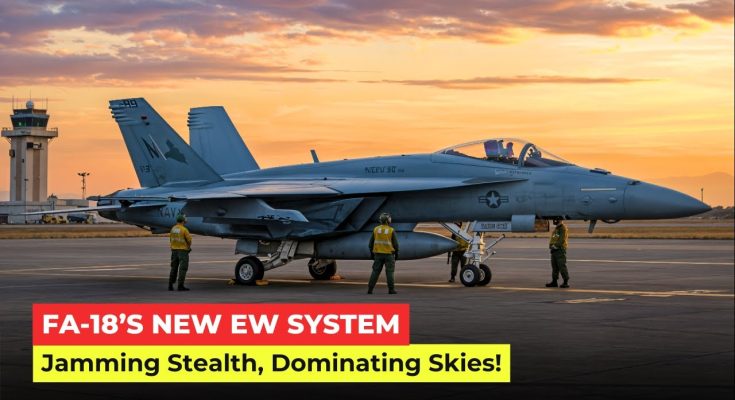The FA-18 Hornet, a versatile and widely used multirole fighter aircraft, has long been a cornerstone of the U.S. Navy’s fleet. Known for its agility, adaptability, and combat capabilities, the FA-18 is now evolving into a formidable force in electronic warfare (EW). With the introduction of new electronic warfare systems, particularly its cutting-edge EW suite, the FA-18 could potentially challenge advanced aircraft like China’s J-20, which is heralded as a fifth-generation stealth fighter.
The FA-18 Hornet’s Evolution
The FA-18 Hornet has seen numerous upgrades over the years, transitioning from a carrier-based fighter to a highly versatile aircraft capable of performing a wide array of roles, from air superiority to ground attack. The most recent upgrade, the EA-18G Growler, which is based on the FA-18, is a dedicated electronic warfare variant of the Hornet. The Growler’s primary mission is to disrupt or deceive enemy radar and communications, providing the U.S. Navy with an unmatched advantage in contested airspaces.
The new electronic warfare capabilities being added to the FA-18, including advanced radar jamming systems and electronic countermeasures, are pushing the aircraft even further into the realm of strategic warfare. These capabilities make the FA-18 a “stealth killer”, particularly when operating against advanced adversaries like China’s J-20 stealth fighter.
The Electronic Warfare Advantage
The new electronic warfare systems integrated into the FA-18 are designed to jam enemy radar, confuse missile systems, and disrupt enemy communications. These systems are vital in modern warfare, where aircraft need to operate in environments filled with advanced radar systems, surface-to-air missiles, and other high-tech threats. The FA-18’s EW suite can engage in electronic attack (EA) missions, where it confuses or blinds enemy radar and missiles, allowing friendly aircraft to penetrate airspace with reduced risk of detection or targeting.
One of the FA-18’s key advantages in electronic warfare is its flexibility. As a carrier-based platform, it can be deployed anywhere in the world, creating a mobile EW platform that can adapt to different operational environments. The Growler, for example, is capable of disrupting enemy radar systems and targeting sensors, offering a powerful advantage when facing advanced aircraft like the J-20.
The J-20: China’s Fifth-Generation Stealth Fighter
The J-20, developed by China, is a fifth-generation stealth fighter that is designed to rival aircraft like the F-22 and F-35. With its low-observable stealth design, advanced sensors, and long-range strike capabilities, the J-20 poses a significant threat to U.S. and allied forces. Its design prioritizes stealth to avoid detection by radar, allowing it to operate in contested airspaces and strike high-value targets with minimal risk.
However, as with all stealth aircraft, the J-20’s effectiveness depends heavily on its ability to avoid detection by advanced radar systems. In this regard, electronic warfare capabilities are critical. While the J-20’s stealth gives it a significant edge in avoiding detection, it is not immune to electronic countermeasures that can disrupt its radar, navigation, and communications systems.
The FA-18’s Potential to Challenge the J-20
The FA-18’s new EW capabilities could serve as a powerful counter to the J-20’s stealth advantages. Jamming systems, for example, can overwhelm the J-20’s sensors and radar, preventing it from maintaining situational awareness or tracking enemy aircraft. Moreover, the FA-18 can use its electronic warfare capabilities to blind or confuse enemy missile guidance systems, significantly reducing the threat of interception.
While the J-20 has advanced stealth features, it is not entirely immune to electronic warfare tactics. Stealth can only go so far in a modern conflict where electronic warfare plays a critical role. The FA-18’s role as a versatile carrier-based platform equipped with advanced EW systems gives it a unique advantage in neutralizing the J-20’s stealth and technological superiority in certain scenarios.
Conclusion: A New Era of Aerial Warfare
The FA-18 Hornet, particularly in its electronic warfare-capable EA-18G Growler variant, is evolving into a critical asset for the U.S. Navy and allied forces, especially in an era where electronic warfare is becoming as important as air combat and firepower. With its ability to challenge advanced stealth fighters like the J-20 through electronic countermeasures, the FA-18 could tip the balance in high-stakes conflicts where stealth alone may not be enough to secure dominance in the skies.
While the J-20 represents a significant technological leap in China’s air force capabilities, the FA-18’s integration of next-generation EW systems presents a new kind of threat: one that goes beyond traditional weapons systems and into the realm of cyber and electronic warfare. In this new age of aerial combat, stealth is no longer the only trump card, and the FA-18’s ability to disrupt enemy systems may prove crucial in neutralizing the J-20’s advantages. As both aircraft continue to evolve, the future of air warfare may depend just as much on electronic supremacy as on traditional fighter capabilities.



